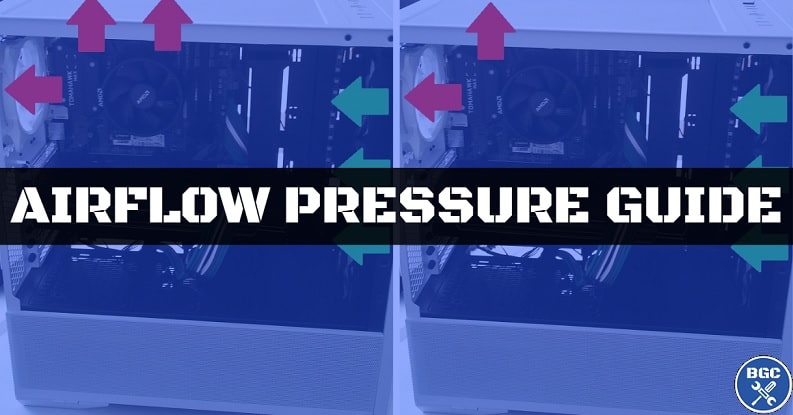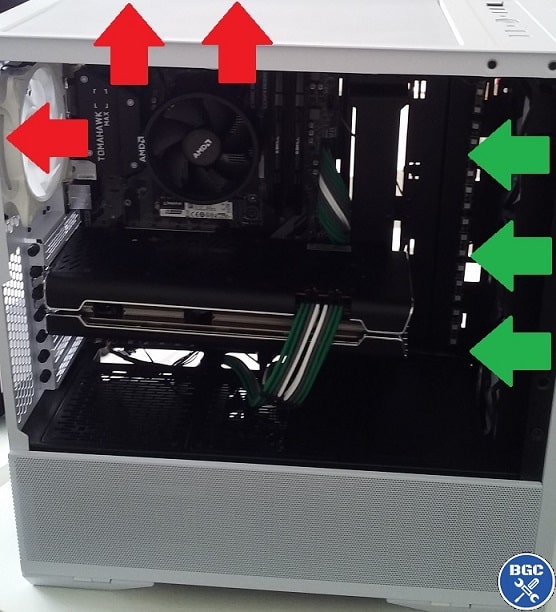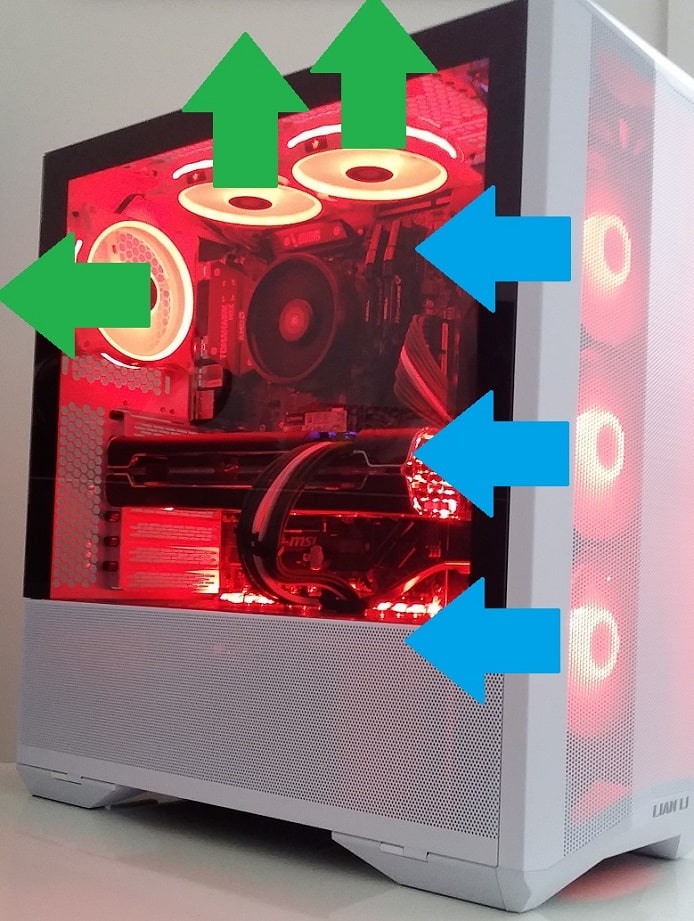Home > Assemble PC > Best Fan Setup
Positive vs Negative vs Neutral Pressure in Your Case (PC Airflow Optimization)
Choosing the Best Fan Setup for 5, 6, or 7 Fans in a Gaming PC (etc)

Published: February 13, 2023
If you have say 5, 6, or 7 fans to install in your PC build, you may wonder what the best fan setup is and where to install them for optimal airflow. Even if you have more or less fans in your computer (eg 3-4 fans which is very common), the question of where to position your PC fans is something I see people asking all the time. When it comes to PC airflow optimization, you basically have three options:
- Positive Pressure (more intake fans than exhaust fans)
- Negative Pressure (more exhaust fans than intake fans)
- Neutral Pressure (same amount of intake and exhaust fans)
See Also: How to Install Extra Fans in PC
What is Positive Pressure in a PC?
In a computer case, the concept of positive pressure, negative pressure, and neutral pressure refers to the balance of air pressure between the inside and outside of the case.
Positive pressure airflow occurs when there is more air being brought into the case than being expelled out. This can result in a small amount of extra air being trapped inside the case, which can help to prevent dust from entering the system and lead to easier/less maintenance of your PC.
 What positive pressure airflow looks like (more air coming in than out)
What positive pressure airflow looks like (more air coming in than out)To setup positive pressure in your PC case, you can install more intake fans vs exhaust fans so that more air is coming in than going out. Alternatively, you can set your intake fan/s to operate a little faster than your exhaust fans, which will have the same effect (more air in vs out).
Note for Beginners: Intake fans are ones that draw/suck cool air in from outside the case, and are usually installed in the front of a case. Exhaust fans are ones that push hot air out of the case, and are typically placed in the rear or the rear-top of the case. A fan can be installed to be either an intake or an exhaust fan - the orientation that you install it will change its function (see how to install PC fans for more).
What is Negative Pressure in a PC?
Negative pressure airflow occurs when there is more air being expelled from the case than being brought in, which is typically created by having more exhaust fans vs intake fans (but can also be a by-product of having a very breathable case). This may result in a higher amount of dust being pulled into the system (through gaps in the case), and this is the main downside of a negative pressure setup.
But the potential benefit of a negative pressure setup is that it may be more effective at dispersing hot air within your PC - negative pressure in a PC is generally said to lower internal temperatures relative to positive pressure (because getting hot air out of a case is typically more important overall when compared to drawing more cool air in).
However, how much of a difference a negative pressure setup makes to cooling and temperatures depends on various factors, such as the case in question. Not all cases are designed to work well with a negative pressure setup.
 What negative pressure airflow looks like (more air going out than in)
What negative pressure airflow looks like (more air going out than in)What is Neutral Pressure in a PC?
Then you have neutral pressure, where you have an equal amount of intake fans and exhaust fans. Some claim it's the most balanced option for both optimal airflow and minimal dust accumulation. But which is best? Positive pressure, negative pressure, or neutral pressure within your computer? The truth is, there is no clear best fan setup for all situations, with each airflow setup having their advantages.
 What neutral pressure airflow looks like
What neutral pressure airflow looks likePositive vs Negative vs Neutral Pressure in PCs
Any of the 3 main types of air pressure setups can work well. But what you will see within DIY PC circles is most people recommending a positive or neutral airflow setup (and rarely a negative one).
Your own decision between positive vs negative vs neutral pressure airflow will come down to factors such as how many fans you have to install, where your hottest components are located within the case, personal preference as to whether you want to fully maximize every extra little bit of cooling performance at the expense of extra dust build-up on your fans (negative pressure, assuming your case works well with a negative pressure that is), or whether you want the opposite of less dust and less maintenance and you're okay with potentially higher temperatures within your system (positive pressure).
 Comparison of positive (left), neutral (middle), and negative (right) airflow pressure
Comparison of positive (left), neutral (middle), and negative (right) airflow pressureHowever, when you look at tests between say positive and negative pressure PC fan setups, there typically isn't a huge difference overall in terms of system temperatures. The thing is, computer cases are not air-tight, and any differences in pressure is unlikely to make a big difference on cooling performance and temperatures.
But same goes for dust build-up, many will argue that the whole debate of positive vs negative vs neutral airflow really doesn't matter, and that either method will accumulate the same amount of dust. As I said, there's no strong consensus on what the best fan setup is, and if you ask different PC builders you'll get different responses based on their subjective experience.
If you're in doubt, if you have an equal amount of fans to install I would just do a neutral airflow setup, and if I had an odd amount of fans I would do a positive airflow setup. In most computer cases that is - the odd case out there may be better suited to a negative pressure fan setup, so it does really depend on your case. For example, the NZXT H510 case has been proven in tests to behave better with a negative pressure setup, but that case is an exception to the rule.
Best 6 Fan Setup
With a total of 6 fans to install in your PC, in most PC cases I would personally opt for either a neutral pressure setup, or a slightly positive pressure setup by running the front 3 intake fans slightly faster than the exhaust fans. Simply install 3 fans in the front as intakes (meaning they are positioned so that they suck/draw air in from out the front), and then have the other 3 in the rear and top as exhaust fans (pushing air out). Here is a diagram of what such a neutral pressure airflow setup looks like in a gaming PC I built for a local one day:
 Green = Exhaust Fans, Blue = Intake Fans
Green = Exhaust Fans, Blue = Intake FansBest 5 Fan Setup
If you have one less fan, you're going to have an uneven amount of fans, meaning that your choices here are a positive pressure or a negative pressure setup. For positive airflow, you can have 3 intake fans in the front (if your case can fit 3 fans there), and 2 exhaust fans (1 in the rear, and 1 on top).
This is what I would do personally, at least in the majority of PC cases. If you wanted to try your hand at a negative pressure setup with your 5 fans, you would have 2 intake fans (in the front) and 3 exhaust fans (1 in the rear, and 2 on top), but make sure to research your particular case model and whether a negative pressure setup is recommended by users who have experience with that case.
Best 7 Fan Setup
What if you have 7 fans though? In that case, I would do as explained in the 6 fan setup from before (3 intake, 3 exhaust) and add that extra intake fan on the bottom of the case if there is an installation location there in your particular case model. If you're buying so many case fans, it's likely that the case you chose will have these bottom mount options. That would make for 4 intake fans, and 3 exhaust fans, meaning you'll have a positive pressure system, which again is probably your best bet with most PC cases these days.
Related: How to Check for Safe GPU Temps
Trusted VPN
VPN software can be important in this day and age, especially if you do lots of online banking and/or use public WiFi whilst travelling. Having a VPN adds an extra layer of security to your PC or laptop when online to help protect your data, passwords, financials, etc from hackers or malicious programs. It can also let you access region-locked content (eg US Netflix from overseas). For gamers their can be even more benefits to using a VPN.
Because they're so popular these days, there are countless VPN providers, and it can be confusing to pick one. If you want my 2 cents, after a lot of research I decided on NordVPN 'cause it's one of the fastest, most reliable VPNs for both gaming and general use, with a lot of credible reviews out there backing that up. They also quite often run very solid deals.
Popular Articles (see all)
Search the Site
About the Author (2025 Update)
I'm an indie game developer currently very deep in development on my first public release, a highly-immersive VR spy shooter set in a realistic near-future releasing on Steam when it's ready. The game is partly inspired by some of my favorites of all time including Perfect Dark, MGS1 and 2, HL2, Splinter Cell, KOTOR, and Deus Ex (also movies like SW1-6, The Matrix, Bladerunner, and 5th Element).
Researching, writing, and periodically updating this site helps a little with self-funding the game as I earn a few dollars here and there from Amazon's affiliate program (if you click an Amazon link on this site and buy something, I get a tiny cut of the total sale, at no extra cost to you).
Hope the site helps save you money or frustration when building a PC, and if you want to support the countless hours gone into creating and fine-tuning the many guides and tutorials on the site, besides using my Amazon links if purchasing something, sharing an article on socials or Reddit does help and is much appreciated.

